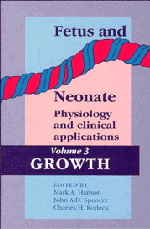Book contents
- Frontmatter
- Contents
- Preface to the series
- List of contributors
- Part I Physiology
- 1 Placental transfer
- 2 Nutrient requirements for normal fetal growth and metabolism
- 3 Hormonal control of fetal growth
- 4 Insulin-like growth factors and their binding proteins
- 5 Metabolism and growth during neonatal and postnatal development
- Part II Pathophysiology
- Part III Clinical applications
- Index
1 - Placental transfer
from Part I - Physiology
Published online by Cambridge University Press: 04 August 2010
- Frontmatter
- Contents
- Preface to the series
- List of contributors
- Part I Physiology
- 1 Placental transfer
- 2 Nutrient requirements for normal fetal growth and metabolism
- 3 Hormonal control of fetal growth
- 4 Insulin-like growth factors and their binding proteins
- 5 Metabolism and growth during neonatal and postnatal development
- Part II Pathophysiology
- Part III Clinical applications
- Index
Summary
Introduction
Belief that the placenta is involved with fetal nutrition was first recorded by Aristotle (Boyd & Hamilton, 1970), although he knew nothing of its microscopic structure or the circulation of fetal and maternal blood through the organ. With current knowledge, it is accepted that the human placenta provides the interface between maternal and fetal circulations across which maternofetal and fetomaternal transfer of nutrients, respiratory gases and waste products occurs. Despite this, understanding of the physiological mechanisms by which transplacental transfer of specific substances occurs is at present limited when compared with understanding of transfer mechanisms in other organs. The purpose of this chapter is, first, to review the functional anatomy of the placenta and the underlying theory of transfer mechanisms which may be applied to the structural model. Current understanding of mechanisms of transfer of selected gases and nutrients is then briefly reviewed. Space limitations prevent an exhaustive bibliography and, for a more comprehensive coverage the reader is referred to Sibley and Boyd (1992) and Morriss, Boyd and Mahendran (1994).
Structure
The mature human placenta has a multivillous architecture (Fig. 1.1a). The term placentome is used to describe one villous tree together with its related maternal circulation. The trunk of the tree is the stem villus from which arise the loosely arranged intermediate villi. Transfer is thought to occur mainly across the outer cell layer, or syncytiotrophoblast, of the more peripherally located mature intermediate villi with their abundant terminal villi.
- Type
- Chapter
- Information
- Publisher: Cambridge University PressPrint publication year: 1995



